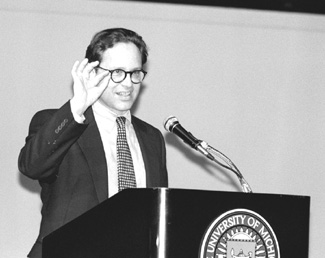The University Record, April 8, 1998
By Joel Seguine
News and Information Services
|
|
|
Atlantic Monthly correspondent Nicholas Lemann’ s appearance at the U-M marked the first program in a new series, Dialogues on Diversity. Photo by Bob Kalmbach |
The great public debates one might have expected at the inceptions of meritocracy and affirmative action never happened. But both are combining now in what Nicholas Lemann, national correspondent for The Atlantic Monthly, called “The Late Debate” in an Evenings at Rackham lecture March 30, part of the Series in American Values.
Lemann’s appearance at Rackham Auditorium was also the first of a new series, Dialogues on Diversity, an initiative of the Graduate School designed to enrich campus discussion and encourage honest dialogue about diversity.
Lemann, who has written widely about issues of race and class in America, used research for his forthcoming book about meritocracy as a basis for the lecture.
The term came, he said, from a 1971 book by British sociologist, Michael Young. In The Rise of the Meritocracy, Young argued that social justice would suffer in a society based primarily on merit, as in the use of standardized tests for advancement. The debate on affirmative action in higher education now raging in the United States is a result, Lemann said, of departing from the policy of using standardized tests in admissions in favor of programs designed to address past discrimination. He went on to trace the steps leading to the current controversies.
IQ tests administered by psychologist Carl Brigham to Army recruits during World War I marked the beginning of standardized testing in the United States, Lemann said. Brigham then joined the faculty at Princeton University where he invented the Scholastic Aptitude Test (SAT). Lemann noted that in 1948 the Educational Testing Service (ETS) was founded, a merger of the SAT and other tests under the College Board.
The better known figure in the history of meritocracy, Lemann said, was James Bryant Conant, president of Harvard University in 1933-53. Early in his tenure, Conant created the Harvard National Scholarships, given to applicants from around the country purely on the basis of SAT scores, a requirement later extended to all applicants. Conant’s “grand educational vision,” as Lemann put it, was not only “to make public education the norm in the spirit of the frontier as a leveler of opportunity,” but also to select an intellectual elite for leadership in society. “The idealism of Conant cannot be overstated,” Lemann said. The acceptance of Conant’s ideas, the widening use of the SAT as the standard for university admissions, and the formation of the ETS were never publicly debated and received no journalistic notice, Lemann said.
The formal origin of affirmative action as we know it began with President Lyndon Johnson’s Executive Order 11246 signed on Sept. 24, 1965, requiring federal contractors “to take affirmative action to ensure that applicants are employed. . .without regard to their race, creed, color, or national origin.” It was not reported in the press until three weeks later, Lemann said. Enforcement of the order was given to the Labor Department, and private industry soon began to adopt affirmative action policies by consensus. The current “late debate” on affirmative action should soon be followed by one over meritocracy, Lemann stated.
The program continued following Lemann’s address with brief presentations on the topic by Deborah Malamud, assistant professor of law; David Featherman, director of the Institute for Social Research; Angela Campos, a senior in the Residential College; and Michael Nettles, professor of education and director of the Frederick D. Patterson Research Institiute, established in 1996 and the first major center in the nation devoted to Black educational data analyses and policy research.
Lemann’s appearance was co-sponsored by the Michigan Journalism Fellows program.


